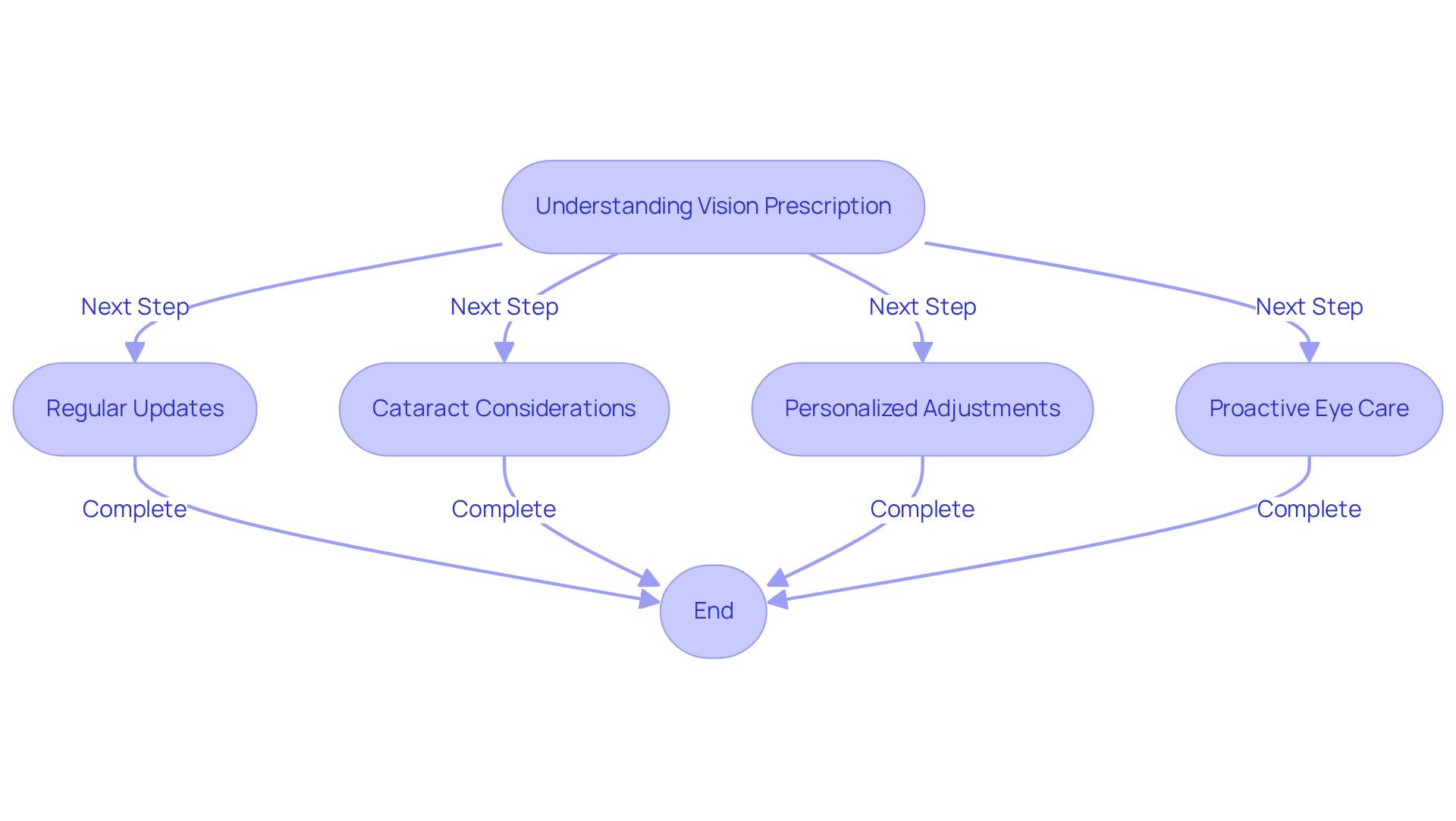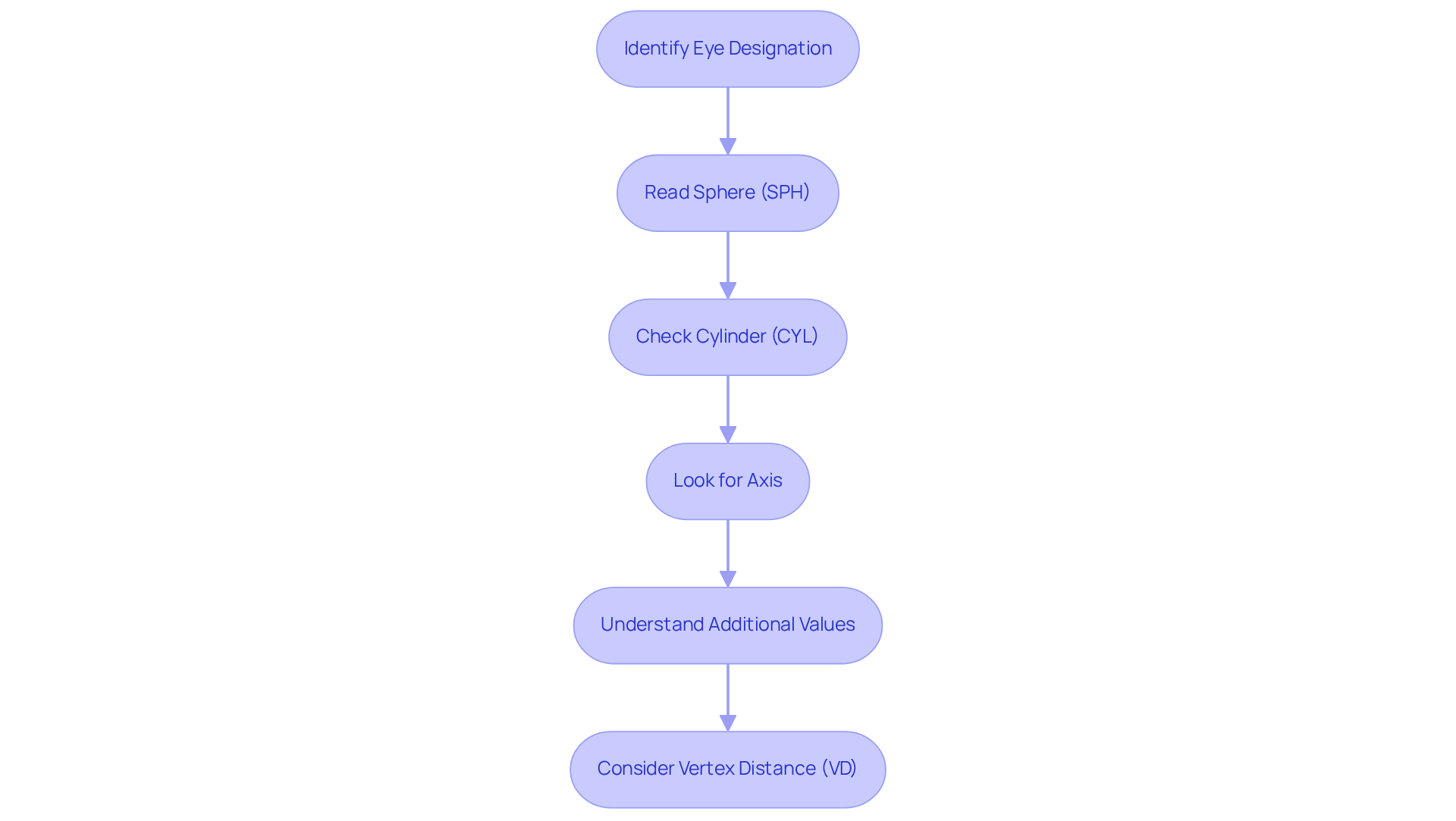Posted by: Northwest Eye in General on November 17, 2025
Introduction
Understanding the nuances of vision prescriptions is essential for anyone, especially for cataract patients who may feel overwhelmed by the complexities of their eyesight. We understand that the symbols ‘+’ and ‘-‘ can carry significant implications, indicating whether one struggles with nearsightedness or farsightedness. Knowing how to interpret these symbols can lead to better eye health and clarity.
However, it’s common to feel confused or anxious when faced with these terms. This article delves into the meanings behind these critical prescription values, offering insights that empower you to take charge of your vision. We are here to help you navigate this journey and make informed decisions about your eyewear.
Clarify the Meaning of Plus and Minus in Eyewear Prescriptions
When it comes to eyewear recommendations, the presence of a plus sign (+) next to your prescription indicates what eyesight + or – means. This indicates that the glasses are meant to help with farsightedness, or hyperopia, which means you may find it challenging to see things that are close to you. On the other hand, eyesight – means nearsightedness, or myopia, where distant objects can be a bit blurry. The numbers following these symbols tell you how strong your lenses need to be, measured in diopters. For example, a prescription of +2.00 indicates what your eyesight + means, requiring a lens that adds two diopters of strength for clear vision up close, while -2.00 shows what your eyesight – means, indicating a need for two diopters of adjustment for seeing things far away.
Understanding these basics is really important, especially if you’re someone who might be adjusting to changes in your vision after cataract surgery. Did you know that about 3 out of every 4 people in America need corrective lenses? This highlights just how crucial it is to grasp what your eyewear prescription means. Regular, comprehensive eye exams are vital for maintaining and improving your sight, as they can catch potential eye issues early on.
If you notice any changes in your eyesight, it’s common to feel concerned. We encourage you to reach out to a medical professional. Early diagnosis and treatment can make a significant difference in your eye health.

Identify Common Vision Conditions Linked to Prescription Values
Common vision conditions associated with prescription values include:
-
Nearsightedness (Myopia): If you’ve ever struggled to see distant objects clearly, you might be experiencing myopia. This condition is often indicated by a negative prescription, which means the eyesight – means it is quite common among cataract patients. Many find that the combination of myopia and cataracts can lead to significant visual impairment, which can be frustrating.
-
Farsightedness (Hyperopia): On the other hand, hyperopia, which means a positive prescription, affects your eyesight, and a positive prescription means difficulty in seeing nearby objects. This condition is especially frequent in older individuals, and cataract patients may find it particularly challenging when engaging in tasks that require detailed sight.
-
Astigmatism: If you notice blurred vision at all distances, astigmatism could be the culprit. Defined by an irregular curvature of the eye, it’s indicated by a cylindrical value in your prescription. Research shows that about 40% of adults are impacted by astigmatism, and those with cataracts often experience increased glare and difficulties at night.
-
Presbyopia: As we age, presbyopia naturally affects our close vision, often leading to the need for reading glasses or multifocal optics. At Northwest Eye, we understand how important it is to have clear vision at all distances. Our Comprehensive Presbyopia Package utilizes advanced lens technologies, including accommodating, multifocal, or extended depth of focus lenses, to help you rely less on glasses. As cataract patients age, presbyopia can become more pronounced, prompting necessary adjustments in prescriptions. Our innovative Light Adjustable Lens (LAL) offers a customizable solution, allowing you to fine-tune your correction after cataract surgery. Remember, post-operative care is essential; wearing UV protective goggles for up to 6 weeks and possibly needing 2 to 5 adjustments can significantly enhance your sight.
Understanding these conditions is vital for you as a patient. It helps you identify your visual needs and appreciate the importance of precise recommendations. Eye care specialists emphasize that regular eye exams are crucial for monitoring these conditions, especially for cataract patients, to ensure optimal sight correction and overall eye health.
We are here to help you through this process, ensuring you feel supported every step of the way.

Understand the Importance of Your Vision Prescription for Eye Health
Your eye care recommendation is more than just a series of numbers; it’s essential for understanding what your eyesight + or – means for maintaining optimal eye health. We understand that navigating eye care can feel overwhelming, but precise recommendations ensure you receive the right lens strength tailored to what your eyesight means for your unique sight needs. This greatly reduces the chances of eye fatigue and migraines, which is what eyesight + or – means. Research shows that frequent headaches and blurred vision are common signs linked to improper eyewear adjustments, which indicates that maintaining proper eyesight means having regular updates, especially after significant changes like cataract surgery. For instance, cataracts can lead to blurred vision and increased sensitivity to light, which means that accurate recommendations are crucial for your eyesight and overall comfort and clarity.
At Northwest Eye, we’re proud to offer innovative solutions like the Light Adjustable Lens (LAL), which allows for personalized adjustments after surgery. This advanced technology uses a special material that reacts to UV light, enabling your doctor to customize your eye correction based on your lifestyle needs. Eye care specialists emphasize that being proactive about your eyesight means ensuring your eyewear is current, which can significantly enhance your quality of life. Dr. Sophia Moh states, “By remaining proactive about your eye health and ensuring your eyewear is up to date, you can maintain clarity of sight and overall eye well-being.”
It’s common to feel a bit disoriented when adjusting to new eyewear, with adjustment times ranging from 2 days to 2 weeks. This underscores the necessity for regular updates to your lens requirements. By understanding the importance of your eyewear details and the advanced options available at Northwest Eye, you can take informed steps to manage your eye health effectively, which ultimately means maintaining optimal eyesight. Remember, we are here to help you through this process.

Interpret Your Vision Prescription: A Step-by-Step Guide
To interpret your vision prescription, we understand it can feel a bit overwhelming. Here’s a simple guide to help you through it:
-
Identify the Eye Designation: Look for ‘OD’ (right eye) and ‘OS’ (left eye) on your order. This helps you know which eye each measurement refers to.
-
Read the Sphere (SPH): This number indicates the lens power needed for nearsightedness or farsightedness. In terms of eyesight, a negative number means myopia, while a positive number means hyperopia. Understanding this is crucial for what your eyesight + or – means.
-
Check the Cylinder (CYL): If you see this value, it indicates astigmatism correction. It can be positive or negative, depending on the type of astigmatism. It’s important to note that 74% of the population has low-level astigmatism (less than 1 diopter), so grasping this aspect is essential for your eyewear.
-
Look for the Axis: This number, ranging from 1 to 180, indicates the orientation of astigmatism correction. Knowing this helps ensure your lenses are just right for you.
-
Understand Additional Values: If your prescription includes ‘ADD’, this indicates additional power needed for reading or close work, often relevant for presbyopia. We know how important it is to see clearly at all distances.
-
Consider Vertex Distance (VD): Typically around 12 millimeters for eyeglasses, this measurement is vital for ensuring the correct optical power.
By following these steps, you can gain a clearer understanding of your vision needs and ensure that your eyewear is tailored to your specific requirements. As one specialist pointed out, “Your vision implant isn’t merely a medical apparatus; it’s the key to how you’ll perceive the world each day.” This highlights the importance of understanding your prescription in relation to your lens implant, especially with innovative options like the Light Adjustable Lens offered at Northwest Eye.
To further enhance your understanding, we encourage you to watch our video that explains how the Light Adjustable Lens works and hear directly from our specialists at Northwest Eye. Remember, it’s important to know that eye doctors cannot charge extra fees for providing your eyeglass prescription, empowering you to make informed choices about your eyewear. With this knowledge, you can enhance your overall vision experience. We are here to help you through this process.

Conclusion
Understanding the distinctions between plus and minus values in eyewear prescriptions is essential for anyone navigating vision changes, especially cataract patients. We understand that recognizing a plus sign (+) indicates farsightedness and a minus sign (-) denotes nearsightedness can feel overwhelming. However, this knowledge empowers you to make informed decisions about your eye care, enhancing your overall visual clarity and comfort.
This article highlights various common vision conditions linked to prescription values, such as:
- Myopia
- Hyperopia
- Astigmatism
- Presbyopia
It’s common to feel uncertain about these terms, but knowing them can help you better understand your needs. Regular eye exams and personalized eyewear adjustments are crucial, particularly after significant changes like cataract surgery. Innovative solutions, like the Light Adjustable Lens, are available to further tailor your vision correction, ensuring you receive the most suitable care for your unique needs.
Ultimately, being proactive about understanding and interpreting eyewear prescriptions can significantly impact your eye health and quality of life. We encourage you to consult with eye care professionals regularly, stay updated on prescription changes, and explore advanced options that enhance your vision. By taking these steps, you can maintain optimal eyesight and navigate the complexities of your vision with confidence and clarity. Remember, we are here to help you through this process.
Frequently Asked Questions
What does a plus sign (+) in an eyewear prescription indicate?
A plus sign (+) indicates that the glasses are meant to help with farsightedness, or hyperopia, which means you may find it challenging to see things that are close to you.
What does a minus sign (-) in an eyewear prescription indicate?
A minus sign (-) indicates nearsightedness, or myopia, where distant objects can be a bit blurry.
How are the strength of lenses measured in an eyewear prescription?
The strength of lenses is measured in diopters, with numbers following the plus or minus signs indicating how strong the lenses need to be.
What does a prescription of +2.00 mean?
A prescription of +2.00 means that the lenses need to add two diopters of strength for clear vision up close.
What does a prescription of -2.00 mean?
A prescription of -2.00 indicates a need for two diopters of adjustment for seeing things far away.
Why is it important to understand eyewear prescriptions?
Understanding eyewear prescriptions is crucial, especially for individuals adjusting to changes in vision, such as after cataract surgery, and because a significant portion of the population requires corrective lenses.
How often should one have eye exams?
Regular, comprehensive eye exams are vital for maintaining and improving sight, as they can catch potential eye issues early on.
What should you do if you notice changes in your eyesight?
If you notice any changes in your eyesight, it is important to reach out to a medical professional, as early diagnosis and treatment can significantly impact eye health.






